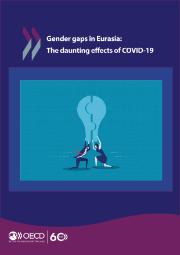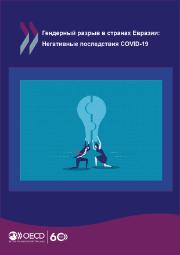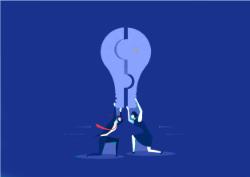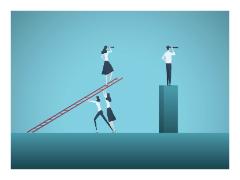Gender Gaps in Eurasia
|
|
Gender equality is not just a moral imperative, it is also critical to the creation of stronger, more sustainable and more inclusive economies. OECD estimates suggest that if women’s participation rates reached those of men by 2030, GDP would increase by around 12%. The OECD has long placed gender equality at the top of its agenda. The OECD Gender Initiative examines barriers to gender equality in education, employment, and entrepreneurship. The OECD Eurasia Competitives Programme works to advance women’s equality and empowerment in the Eastern Partner (EaP) region and Central Asia, addressing the specific social, institutional and economic realities of these countries. : Gender Gaps in Eurasia: The daunting effects of COVID-19Гендерный разрыв в странах Евразии: Негативные последствия COVID-19 |
Gender Gaps in Eurasia: The daunting effects of COVID-19
COVID-19 has triggered an economic and public health crisis that has exacerbated gender gaps worldwide – and countries in the EaP region and Central Asia are no exception. First estimates show that the pandemic could set progress towards gender equality in the region back 15 years. A variety of gender gaps – pay, poverty, access to finance, digitalisation – appear to be growing:
- Access to sexual and reproductive health services for women has become more difficult
- Women across Eurasia have been facing increased levels of domestic violence.
- Women in Eurasia tend to be disproportionately employed in harder-hit or vulnerable sectors, such as textiles, food services and accommodation, leading to greater reductions in pay and employment.
- The domestic care burden, traditionally taken up by women, has greatly increased as a result of measures taken to contain the spread of the virus.
At the same time, women in the region often have fewer resources with which to cushion the adverse effects of the pandemic and a much more limited voice in public and private decision-making. In both public and private spheres, key decision-making roles are overwhelmingly held by men, and indicators of financial literacy and labour-market opportunity point to continuing barriers that women face. Yet women must have a strong role in shaping post-crisis policies if we are to ensure an inclusive recovery for women and men alike. The evidence of past crises shows how their exclusion from decision-making can warp recovery policies, often resulting in significant gaps.
Publication
 |
Gender Gaps in Eurasia: The daunting effects of COVID-19 The OECD has closely co-operated with government, private sector, civil society and international partners to formulate policy recommendations that support gender equality in the Eastern Europe, South Caucasus and Central Asia – the Eurasia region. This report summarises the analysis of gender-specific obstacles that women in Eurasia face as a result of the COVID-19 pandemic, ranging from wage and employment disparities to domestic violence and healthcare access issues. The report suggests five sets of actions to ensure a sustainable and inclusive recovery for all: (1) measures to enhance women’s access to public health coverage and services; (2) steps to protect women’s integrity and reduce domestic violence; (3) measures to support women’s economic empowerment and social well-being; (4) steps to enhance women’s influence in the public sphere; and (5) tools and processes to enhance the quality of gender decision-making in government. |
| Гендерный разрыв в странах Евразии: Негативные последствия COVID-19
ОЭСР тесно сотрудничает с правительством, частным сектором, гражданским обществом и международными партнерами в целях разработки политических рекомендаций, способствующих достижению гендерного равенства в Восточной Европе, странах Закавказья и Центральной Азии — регионе Евразии. В настоящем отчете описаны результаты анализа гендерных препятствий, с которыми женщины Евразии сталкиваются в контексте пандемии COVID-19, начиная от неравенства в оплате труда и занятости до бытового насилия и проблем с доступом к здравоохранению. Он предлагает пять комплексов мер, призванных обеспечить устойчивое и инклюзивное восстановления для всех: (1) меры по упрощению доступа женщин к общественному здравоохранению и услугам, (2) меры по защите неприкосновенности женщин и снижению уровня бытового насилия, (3) меры по расширению экономических прав и возможностей женщин и повышению уровня их социального благополучия, (4) меры по повышению влияния женщин в общественной сфере и (5) инструменты и процессы для повышения качества принятия решений с учетом гендерных аспектов в правительстве. |
 |
Previous Events
Gender gaps in Eurasia: Daunting Effects of COVID-19Date: Webinar on 9 February 2021
 |
 |
 |
The webinar discussed the policy note Gender Gaps in Eurasia, which summarises the main challenges facing women in the region following the onset of the COVID-19 pandemic and presents priority actions and policy recommendations to ensure a more inclusive and sustainable recovery for all. As COVID-19 has exacerbated many of the problems that confront women in the Eurasia region and thrown gender inequalities into sharp relief, it is crucial for governments in Eastern Europe, the South Caucasus and Central Asia to understand the issues, prioritise actions and exchange ideas on how better to plan the recovery. This webinar presented the main policy issues and options for supporting women and men across the region, building on OECD experience, in order to ensure that the recovery is as equitable and inclusive as possible.
The COVID-19 pandemic has highlighted the socio-economic vulnerability of women in the Eastern Partner region (EaP) and Central Asia. Domestic violence has increased dramatically; women have taken on more unpaid work; remittance flows to households have fallen; and labour market conditions have deteriorated, particularly in sectors relying heavily on female workers and with high levels of informality. Women are also at the forefront of the fight against COVID-19, representing around 70% of the medical staff worldwide. First OECD estimates show that the COVID-19 pandemic could set back gender parity in Eurasia by around 15 years.
Read a summary of the webinar/ Краткое резюме вебинара
Key Contacts
|
Gabriela Miranda Senior Policy Analyst Global Relations |
Talisa Zur Hausen Policy Analyst Global Relations |
Related Documents


